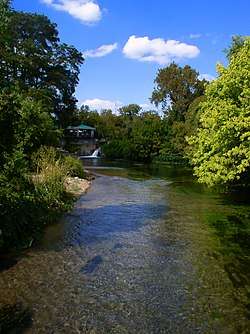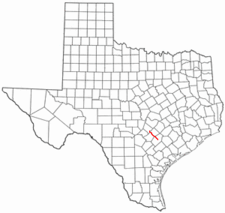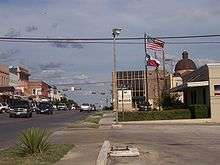San Marcos River
The San Marcos River rises from the San Marcos Springs, the location of Aquarena Springs, in San Marcos, Texas. The springs are home to several threatened or endangered species, including the Texas Blind Salamander, Fountain Darter, and Texas Wild Rice. The river is a popular recreational area, and is frequented for tubing, canoeing, swimming, and fishing.
| San Marcos River Río San Marcos | |
|---|---|
 The San Marcos River downstream from the San Marcos Springs | |
 Map of the San Marcos River | |
| Location | |
| Country | United States |
| State | Texas |
| Physical characteristics | |
| Source | San Marcos Springs |
| • location | San Marcos, Texas, U.S. |
| • elevation | 575 ft (175 m)[1] |
| Mouth | Guadalupe River |
• location | Gonzales County, Texas, U.S. |
| Length | 75 mi (121 km) |
| Basin size | 522 sq mi (1,350 km2) |
| Discharge | |
| • average | 236 cu ft/s (6.7 m3/s) |
Course
The river begins at San Marcos Springs, rising from the Edwards Aquifer into Spring Lake. Access to much of the headwaters is restricted because of the delicate ecosystem and numerous rare species. The upper river flows through Texas State University and San Marcos, and is a popular recreational area. It is joined by the Blanco River after four miles, passes through Luling and Palmetto State Park. Near Gonzales it flows into the Guadalupe River after a total of 75 miles (121 km). This course is the first section of the Texas Water Safari.
.jpg)
History
The history and naming of the river is somewhat unclear. It may have been discovered by Alonso de León's expedition in 1689, but some scholars believe they instead had found the Colorado or Navidad rivers. The convention came to call the first sizable river beyond the Guadalupe. However, at the time, the Comal River was often called the Guadalupe, and part of the Guadalupe often called San Ybón. In 1808, the Spanish established San Marcos de Neve, just south of present-day San Marcos. They had friendly relations with the Tonkawa Indians, but the hostile Comanche tribe forced them to leave in 1812. In 1998 and 2015, the river was affected by severe flooding.
Events
San Marcos hosts many events on the San Marcos River. The Texas Water Safari is an event that has run every year since its start in 1963 that uses canoes powered only by human muscle. This event uses the San Marcos River and the Guadalupe River spanning from Aquarena Springs in San Marcos to Seadrift, Texas, a total of 260 miles. This event is actually composed of many events including an information seminar, the safari race, a preliminary race, and another short race. Racers must take enough food and provisions to last them the distance of the race. The Texas Water Safari is billed as the "Worlds Toughest Boat Race" and runs annually on the second Saturday of June.[2]
Another event is the San Marcos River annual San Marcos River Clean-Up. The San Marcos River Clean-Up is an organized spring clean-up of the whole river. Volunteers can either decide between cleaning the debris around the river with the usage of canoes or cooking and baking food for the annual San Marcos River Clean-Up thank you dinner that is provided for all volunteers. The clean-up is coordinated yearly by Tom Goynes, president of the Texas River Protection Association and a board member of SMRF, and is usually the first Saturday of every March.[3]
Wildlife
San Marcos has many different wildlife, including endangered species, that reside in the San Marcos River. Species are listed threatened or endangered based on declining numbers or loss of habitat. The Texas Blind Salamander and the San Marcos Salamander are endangered species that are only found in certain section of the San Marcos River and the Edwards Aquifer.[4]
Another set of endangered species are the Fountain Darter and the San Marcos Gambusia which both reside in the San Marcos River. The Fountain Darter is characterized by the mottled brown body and dark markings that help it camouflage into the bottom of the San Marcos River banks. They have a growing population and flourish in the San Marcos River. The San Marcos Gambusia is characterized by prominent dark stripes along its body. The San Marcos Gambusia population is unknown at the moment and is even considered to be extinct. Both fish require clear, clean, continually flowing water with a stable temperature.
An endangered plant species that is specific to the San Marcos River is Texas Wild Rice. There are only 230 clumps still remaining on the river in two different populations with one population being grown on the Texas State University Campus.[5]
The San Marcos River is considered to be one of the most biologically diverse aquatic ecosystems known in the Southwestern United States. Consequently, the United States Fish and Wildlife Service and Texas Parks and Wildlife Department have designated the San Marcos Springs and Spring Lake critical habitat and some parts of the river are privatized because of this. Critical habitat refers to a particular geographical area that contains all of the physical, chemical and biological attributes needed for the continued success of an endangered plant or animal and that may require special efforts for their management and protection.[6]
Restoration efforts
Much of the San Marcos River is protected via the Edwards Aquifer Habitat Conservation Plan due to the wildlife that reside and the usage of the river. This plan was established in 2006 as an attempt between several Texas cities, that use the many resources of the San Marcos River, to manage aquatic habitats and to manage water resources of the Comal and San Marcos springs. This plan helps manage control of non -native species, species stability, control of native species, sediment removal, reduction of contamination, and flow protection.[7] Work on the San Marcos River banks are the main focus of the restoration projects in a large effort to protect the Edward Aquifer. Non-Native plants will be uprooted and new plants will be planted to take their spots. Also, there will be six new access points to the river in attempts to allow people to get in and out of the water without harm to the river banks. The city will spend close to a million dollars in this restoration attempt. This makes the river a more ideal habitat, while at the same time improving recreation.[8]
See also
References
- Google Earth elevation for GNIS coordinates.
- "Texas Water Safari". Texas Water Safari. Texas Water Safari Corporation. Retrieved 28 April 2014.
- "SMRF Projects". San Marcos River Foundation. San Marcos River Foundation. Archived from the original on 6 March 2014. Retrieved 28 April 2014.
- "Texas Blind Salamander". Texas Park & Wildlife. Texas Parks & Wildlife. Retrieved 28 April 2014.
- "Zizania texana". Center for Plant Conservation. Center for Plant Conservation. Archived from the original on 16 April 2014. Retrieved 28 April 2014.
- "Unique Habitat". Texas State University. Texas State University. Archived from the original on 19 April 2014. Retrieved 28 April 2014.
- "San Marcos River Watershed" (PDF). GBRA. Guadalupe Blanco River Authority. Retrieved 28 April 2014.
- Wilde, Russell (2013-10-19). "New access points, bank restoration in store for San Marcos River". Time Warner Cable News. Retrieved 28 April 2014.
External links
| Wikimedia Commons has media related to San Marcos River. |
| Wikivoyage has a travel guide for Canoeing the San Marcos River. |
- San Marcos River from the Handbook of Texas Online
- San Marcos River Foundation
- Edwards Aquifer
- San Marcos Greenbelt Alliance
- Texas Water Safari
- San Marcos Foundation Projects
- Endangered Species of the San Marcos River
- Species in the Edward Aquifer
- Endangered Species
- Endangered Species of the San Marcos River
- Restoration of the San Marcos River
